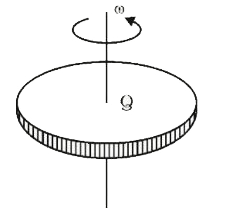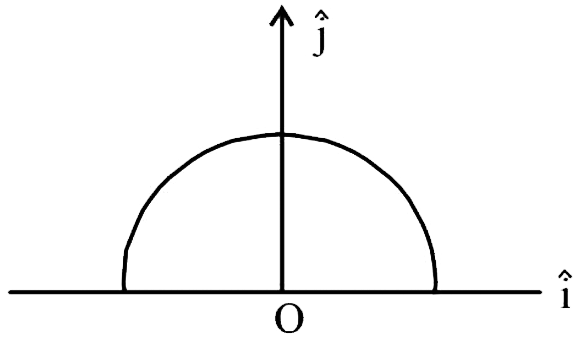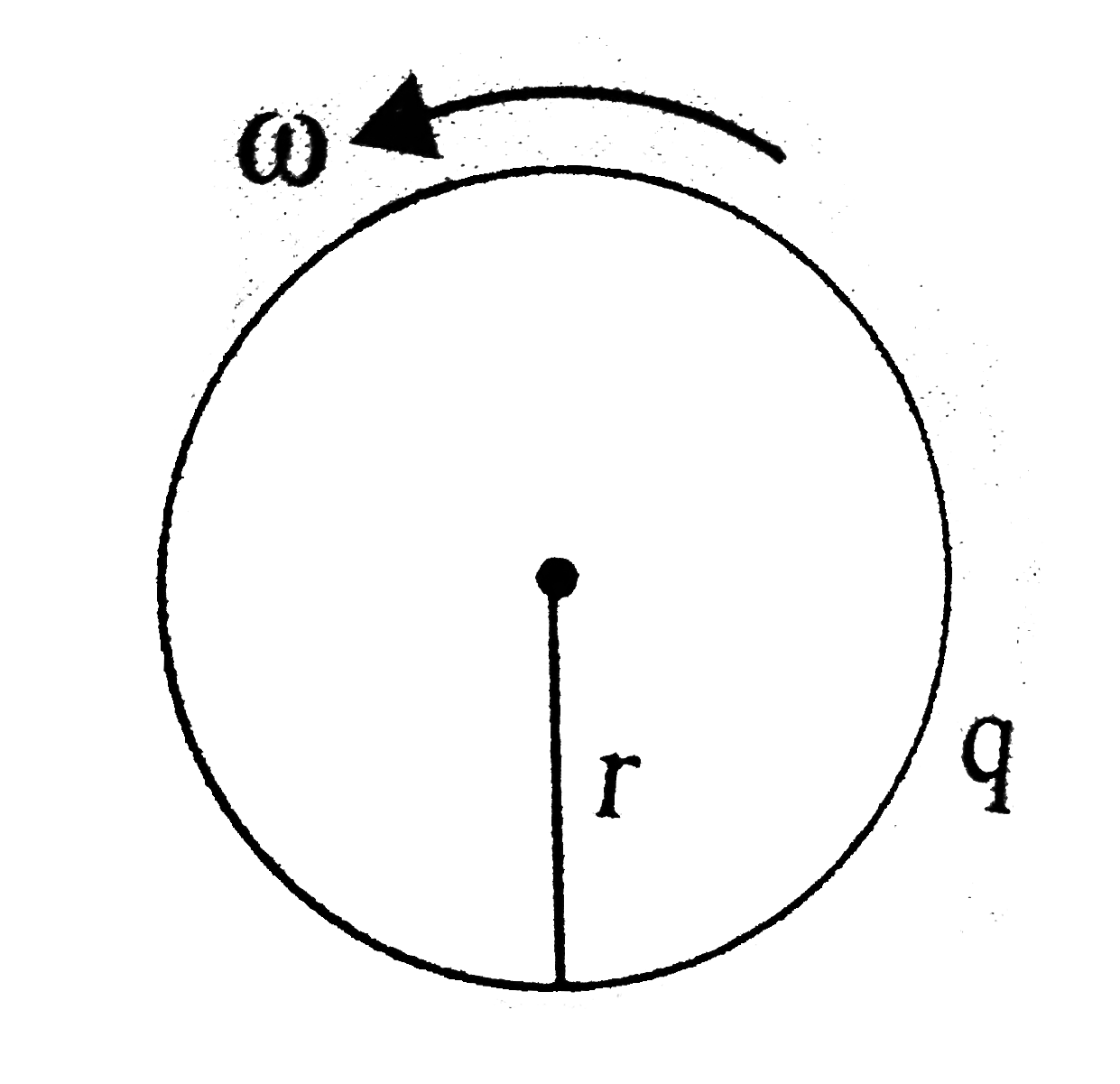There are two concentric and coplanar non-conducting rings of radii and . The charge is distributed uniormly on both rings. The charge on smaller ring is and charge on large ring is . A particle of mass and charge is projected along the axis from infinity. What is the minimum speed of charge at infinity to reach the common centre of rings (take )
a.
b.
c.
d.
The correct Answer is:C
To solve the problem, we need to find the minimum speed of a charge projected from infinity to reach the common center of two concentric non-conducting rings. We will use the principles of electrostatics and energy conservation.
1. Understanding the Setup:
- We have two rings: a smaller ring with radius R and charge q, and a larger ring with radius 4R and charge −8q.
- A particle with mass 10g (or 0.01kg) and charge −q is projected from infinity.
2. Finding the Electric Field:
- The electric field E due to a ring of charge at a point along its axis is given by:
E=kQx(R2+x2)3/2
- For the smaller ring (charge q):
E1=kqx(R2+x2)3/2
- For the larger ring (charge −8q):
E2=−k(8q)x(16R2+x2)3/2
3. Setting the Electric Fields Equal:
- We need to find the point x where the net electric field is zero:
E1+E2=0
kqx(R2+x2)3/2=k(8q)x(16R2+x2)3/2
- Canceling kq and simplifying gives:
x(R2+x2)3/2=8x(16R2+x2)3/2
4. Solving for x:
- Cross-multiplying and simplifying leads to:
8(16R2+x2)3/2=(R2+x2)3/2
- After some algebra, we find that x=2R.
5. Using Conservation of Energy:
- The total mechanical energy at infinity (where potential energy is zero) must equal the total mechanical energy at the point x=2R:
12mv2=U
- The potential energy U at x=2R is given by:
U=k(q(−q)√R2+(2R)2+−8q(−q)√(4R)2+(2R)2)
- Plugging in values:
U=−kq2√5R2+8kq2√20R2=−kq2R√5+4kq2R√5=3kq2R√5
6. Substituting Known Values:
- We know kq2R=2√53:
U=3⋅2√53√5=2
- Therefore, equating energies:
12mv2=2⟹v2=4m
7. Calculating Minimum Speed:
- Substituting m=0.01kg:
v2=40.01=400⟹v=20m/s
Final Answer:
The minimum speed of the charge at infinity to reach the common center of the rings is 20m/s.
- We have two rings: a smaller ring with radius R and charge q, and a larger ring with radius 4R and charge −8q.
- A particle with mass 10g (or 0.01kg) and charge −q is projected from infinity.
- The electric field E due to a ring of charge at a point along its axis is given by:
E=kQx(R2+x2)3/2
- For the smaller ring (charge q):
E1=kqx(R2+x2)3/2
- For the larger ring (charge −8q):
E2=−k(8q)x(16R2+x2)3/2
- We need to find the point x where the net electric field is zero:
E1+E2=0
kqx(R2+x2)3/2=k(8q)x(16R2+x2)3/2
- Canceling kq and simplifying gives:
x(R2+x2)3/2=8x(16R2+x2)3/2
- Cross-multiplying and simplifying leads to:
8(16R2+x2)3/2=(R2+x2)3/2
- After some algebra, we find that x=2R.
- The total mechanical energy at infinity (where potential energy is zero) must equal the total mechanical energy at the point x=2R:
12mv2=U
- The potential energy U at x=2R is given by:
U=k(q(−q)√R2+(2R)2+−8q(−q)√(4R)2+(2R)2)
- Plugging in values:
U=−kq2√5R2+8kq2√20R2=−kq2R√5+4kq2R√5=3kq2R√5
- We know kq2R=2√53:
U=3⋅2√53√5=2
- Therefore, equating energies:
12mv2=2⟹v2=4m
- Substituting m=0.01kg:
v2=40.01=400⟹v=20m/s
The minimum speed of the charge at infinity to reach the common center of the rings is 20m/s.
Topper's Solved these Questions
- TEST PAPERSBook:RESONANCE ENGLISHChapter:TEST PAPERSExercise:PART - II PHYSICS
Explore 106 Videos
- SIMPLE HARMONIC MOTION Book:RESONANCE ENGLISHChapter:SIMPLE HARMONIC MOTION Exercise:Advanced Level Problems
Explore 13 Videos
- TEST SERIESBook:RESONANCE ENGLISHChapter:TEST SERIESExercise:PHYSICS
Explore 130 Videos
Similar Questions
Two concentric conducting shells of radii R and 2R are having charges Q and -2Q respectively.In a region r
View SolutionA non-conducting ring of radius R has charge Q distributed unevenly over it. If it rotates with an angular velocity ω the equivalent current will be:

View SolutionTwo concentric rings placed in a gravity free region in yz-plane one of radius R carries a+Q and second of radius 4R and charge –8Q distributed uniformly over it. Find the velocity with which a point charge of mass m and charge +q should be projected from a a distance 3R from the centre of rings on its axis so that it will reach to the centre of the rings.
View SolutionA Circular ring of radius 3a is uniformly charged with charge q is kept in x−y plane with center at origin. A particle of charge q and mass m is projected frim x=4 towards origin. Find the minimum speed of projection such that it reaches origin.
_2019_CBT5_E01_042_Q01.png)
View SolutionA thin semi-circular ring of radius r has a positive charge q distributed uniformly over it. The net field →E at the centre O is

View SolutionCharge q is uniformly distributed over a thin half ring of radius R. The electric field at the centre of the ring is
View SolutionA conducting ring of radius r having charge q is rotating with angular velocity ω about its axes. Find the magnetic field at the centre of the ring.

View SolutionA conducting ring of radius r having charge q is rotating with angular velocity ω about its axes. Find the magnetic field at the centre of the ring.

View SolutionTwo concentric conducting shells A and B are of radii R and 2R. A charge +q is placed at the centre of the shells. Shell B is earthed and a charge q is given to shell A. Find the charge on outer surface of A and B.
View SolutionA ring of radius R has charge −Q distributed uniformly over it. Calculate the charge that should be placed at the center of the ring such that the electric field becomes zero at apoint on the axis of the ring at distant R from the center of the ring.
View Solution

